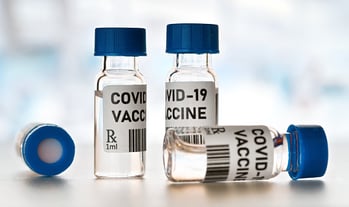The Amazing Race for a Coronavirus Vaccine
As the COVID-19 pandemic raged around the globe, scientists embarked on a race to produce safe and effective coronavirus vaccines in record time. The World Health Organization (WHO) reports that on Dec. 22, 2020, 61 vaccines were currently undergoing clinical development and at least 172 were undergoing pre-clinical development. 
In the United State, two vaccines, the Pfizer BioNTech BNT162b2 vaccine, and the Moderna COVID-19 (mRNA-273) vaccine were approved for emergency authorization by the Food and Drug Administration (FDA) in December 2020 and are now being distributed. The Pfizer BioNTech vaccine was developed through a collaboration between Pfizer Pharmaceutical and BioNTech, a German company founded by husband and wife team Dr. Ugur Sahin, and Dr. Özlem Türeci. Moderna, a Massachusetts-based company, partnered with the National Institutes of Health (NIH) to develop and test a coronavirus vaccine known as mRNA-1273.
Clinical trials demonstrated that the two vaccines have efficacy rates of 94-95 percent in preventing Covid-19.
How Vaccines Work to Stimulate the Immune System
The body has a natural defense mechanism against germs such as the virus that causes COVID-19 that invade our bodies. It’s the immune system. When germs attack and multiply causing an infection, the immune system uses several types of white blood cells to fight that infection. They work in different ways.
Macrophages (white blood cells) swallow up and digest germs and dead or dying cells. They leave behind parts of the invading germs called antigens. The body identifies these antigens as dangerous and stimulates antibodies to attack them. B-lymphocytes are defensive white blood cells. They produce antibodies that attack the pieces of the virus left behind by the macrophages. T-lymphocytes are another type of defensive white blood cell. They attack cells in the body that have already been infected.
The body also keeps a few T-lymphocytes, called memory cells, that go into action quickly if the body encounters the same virus again. When the familiar antigens are detected, B-lymphocytes produce antibodies to attack them.
SARS-CoV-2 Virus Protein Spikes
The SARS-CoV-2 virus is studded with protein spikes that it uses to enter human cells. Using similar technology, both the Pfizer BioNTech and the Moderna vaccines use messenger RNA (mRNA), the genetic material that our cells read to make proteins. To protect their fragile mRNA vaccine, they wrap the mRNA in oily bubbles made of fatty nanoparticles and inject it causing the vaccine particles to bump into the cells, fuse with them, and release the mRNA. The cell’s molecules read the vaccine’s mRNA’s gene sequence and build surrogate spike proteins. While the vaccine’s mRNA from the vaccine is eventually destroyed by the cell, leaving no permanent trace, some of the spike proteins form spikes that migrate to the surface of the cell and stick out their tips. The vaccinated cells also break up some of the proteins into fragments, which also present on the surface of the cells. These protruding spikes and spike protein fragments are then recognized by the immune system which produces antibodies to the virus. The antibodies then latch onto true coronavirus spikes, marking the virus for destruction and preventing further infection by blocking the spikes from attaching to other cells.
Other immune B-cells may also bump into and lock onto the coronavirus spikes and protein fragments on the surface of vaccinated cells. If these B-cells are then activated by helper T-cells, they will start to proliferate and pour out antibodies that target the spike protein to block the spikes from attaching to other cells. Other immune killer T-cells also seek out and destroy any coronavirus-infected cells that display the spike protein fragments on their surfaces.
Fragility of mRNA
The mRNA molecules are fragile and will quickly fall apart at room temperature. Therefore, Pfizer has built special containers with dry ice, thermal sensors, and GPS trackers to ensure the vaccines can be transported at -94 degrees Fahrenheit to stay viable. Moderna’s vaccine needs to be refrigerated, and should be stable for up to six months when shipped and stored at -4 degrees Fahrenheit.
The Pfizer vaccine requires two injections three weeks apart to prime the immune system sufficiently to fight off the coronavirus. Moderna’s vaccine also requires two injections, given four weeks apart.
In July, Pfizer made a $1.95 billion deal with the US government’s Operation Warp Speed, the multiagency effort to rush a vaccine to market, to deliver 100 million doses of the vaccine. The arrangement is an advance-purchase agreement, meaning that the company won’t get paid until they deliver the vaccines. Pfizer did not accept federal funding to help develop or manufacture the vaccine, unlike other front-runners Moderna and AstraZeneca.
In December, the Pfizer-BioNTech COVID-19 and Moderna vaccines were authorized for emergency use by the U.S. Food and Drug Administration (FDA) under an Emergency Use Authorization (EUA) to prevent Coronavirus Disease 2019 (COVID-19) for use in individuals 16 years of age and older. They have not, as yet, been fully approved or licensed by the (FDA). The emergency use of this product is only authorized for the duration of the declaration that circumstances exist justifying the authorization of emergency use of the medical product under Section 564(b)(1) of the FD&C Act unless the declaration is terminated or authorization revoked sooner.
References:
Corum J, Zimmer C, The New York Times, December 14, 2020
http://www.Pfizer.com
http://Modernatx.com




